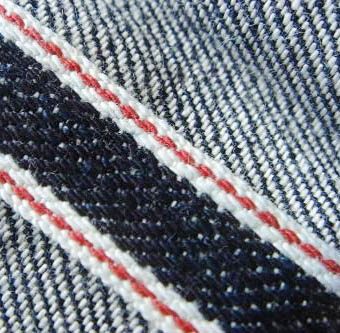[知識]丹寧布料知識補充
出處:
http://acuttie5.pixnet.net/blog/post/25585389-woven%E6%A2%AD%E7%B9%94-vs-knit%E9%87%9D%E7%B9%94-%E7%9A%84%E5%B7%AE%E7%95%B0




針織布的結構變化可以很多,當中的組織主要有三種:
a)平紋布/單面 (Jersey)
b)雙面布 (Interlock)
c)籮紋布 (Rib)
http://www.rawrdenim.com/2011/08/understanding-raw-denim-warp-weft-and-twill/

http://www.rawrdenim.com/2014/08/know-twills-3x1-2x1-plain-weave/




http://acuttie5.pixnet.net/blog/post/25585389-woven%E6%A2%AD%E7%B9%94-vs-knit%E9%87%9D%E7%B9%94-%E7%9A%84%E5%B7%AE%E7%95%B0
1)woven garment (梭織服裝)
梭織布組織是依照紗線的縱橫交錯而成,織品上縱向紗線稱為經紗,橫向紗線稱為緯紗,織品中的經緯紗,按照一定的規律互相交織成組織點,稱為織品組織 (Weaves),為了織成各種各樣的織品,便發展出不同特性的織機,依照所預定的織紋,決定織機上的綜片的數目和穿過綜眼的特點,通過綜片的上升及下降,不斷運動及緯紗不斷往返,編織成各種燦爛繽紛的花紋,織物中經紗浮於緯紗上面的組織點稱為經浮點,相反緯紗浮於經紗的組織點稱為緯浮點.
(全機動織布機 Machinery loom)
它的基本組織可分為下列 二種:
a)平紋 (Plain Weave)
b)斜紋(Twill Weave).
a)平紋 (Plain Weave)
b)斜紋(Twill Weave).
梭織布的種類:
帆布 (Canvas)
平紋布 (Poplin)
毛布 (Flannel)
剪毛絨 (Velvet)
燈芯絨 (Corduroy)
斜紋布 (Twill)
牛仔布 (Denim)
印花牛仔布 (Printed Denim)
提花平紋布(Dobby Poplin)
格仔帆布 (Ribstop Canvas)
帆布 (Canvas)
平紋布 (Poplin)
毛布 (Flannel)
剪毛絨 (Velvet)
燈芯絨 (Corduroy)
斜紋布 (Twill)
牛仔布 (Denim)
印花牛仔布 (Printed Denim)
提花平紋布(Dobby Poplin)
格仔帆布 (Ribstop Canvas)
服裝例如: 牛津紡恤衫, 牛仔/斜布褲, 西裝....
2)knit garment (針織服裝)
針織布組織是通過織針上上落落的動作把紗線形成線圈,而線圈一個一個緊扣相連,便成為針織片;針織布的織造方法,主要有緯編和經編兩種,緯編是在織造時線圈橫向一個連一個編織出來,同一刻只有一枝織針出線圈,經編是所有織針同一時間運作,一刻內以垂直方向產生一排線圈.
在市場上,大部份都是緯編產品,因為成品富彈性,而且色彩圖案變化較大
在市場上,大部份都是緯編產品,因為成品富彈性,而且色彩圖案變化較大
(針織布結構 Knit Fabric Construction)
(針織布圓筒機Circular knitting machine)
針織布的結構變化可以很多,當中的組織主要有三種:
a)平紋布/單面 (Jersey)
b)雙面布 (Interlock)
c)籮紋布 (Rib)
例如日常生活中,許多具有彈性的衣物,如內衣、泳裝、運動服、套頭毛衣, 襪、帽、T恤等,皆常利用此種織法.
最後補充一點
雖然Knit針織的布料比較有彈性也比較柔軟,但是相對的他也比較容易起毛球
Woven梭織(平織)的布料雖然沒有彈性,但是比較透氣穿起來比較涼爽
A woven fabric is:
- two or more sets of yarns (warp and weft) interlaced at right angles to each other
Warp yarns are:
- in the lengthwise direction
- yarn that runs parallel to the selvedge; in denim it’s dyed indigo
- also called “ends” in weaving terms
Weft yarns are:
- in the crosswise direction
- A.K.A. “filling yarn”, runs from selvedge to selvage at right angles to the warp yarn; in denim, this yarn is generally left a natural, un-dyed colour
- also called “filling” or “picks” in weaving terms
NOTE: A simple way to remember and distinguish the two is to look at the “A” in warp and the “E” in weft. The letter “A” has its two vertical strokes, which conveniently goes in the up/down direction like a warp yarn. The letter “E” has three horizontal strokes, which conveniently goes in the left/right direction like a weft yarn.
An awesome visual displaying how the warp and weft interplay. The selvedge is not unique to denim, but a common term referring to fabrics
Twill weave:
- Weave repeats on 2 or more warp & weft yarns & diagonal lines are produced on the face of the fabric
- Interlacing pattern is over more than 1 yarn & then under 1 or more yarns with a progression of “1” to create a diagonal lines
http://www.rawrdenim.com/2014/08/know-twills-3x1-2x1-plain-weave/
3×1
Weft on a 3×1 pair of Naked & Famous denim.
3×1 is the most common in selvedge denim, chiefly because any denim over a 10.5 Oz. per square yard weight is 3×1. What the numbers describe is the number of warp threads versus weft threads. For 3×1, there are 3 warp threads for every weft thread.
If you closely inspect your favorite pair of selvedge denim that is at least 10.5 Oz. in weight, you’ll likely see three threads crossing over every one weft thread. 3×1 is the most common simply because it is the sturdiest weave; denim is a fabric rooted in workwear, so it’s only natural to have it be as durable as possible.
2×1
A lightweight 2×1 denim from Pacific Blue
As you may have guessed, 2×1 is just two warp threads for every weft thread. We’ve coveredsummer weight denim options at Rawr Denim before, which typically clock in at less than 10.5 Oz.
These pairs of denim are likely woven using a 2×1 weave. For those of you who have worn heavyweight denim in the summer, it can get rather…hot down there. A 2×1 provides the durability that denim is known for, while making it more breathable.
PLAIN WEAVE
A plainweave chambray from The Hill-Side
Plain weave is a simple way of saying a 1×1 weave. The warp and weft are aligned so that they form a simple criss-cross pattern. This method is the most simple way for cloth to be woven, as well as one of the cheapest.
By varying the tension of the threads, weavers can make the resulting fabric tighter or looser and stronger or more breathable. Basketweave is a well-known variation of the plain weave method.
In the textile manufacturing business we referred to twills as 4:1, 3:1, etc. - "Four TO one, "Three TO one."


留言
張貼留言